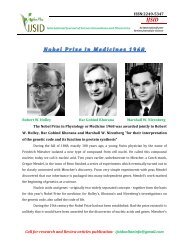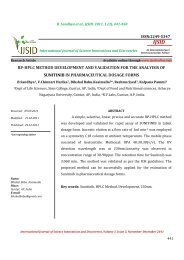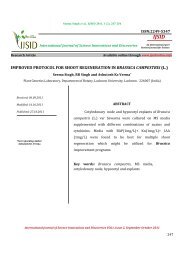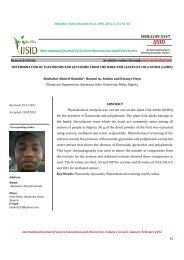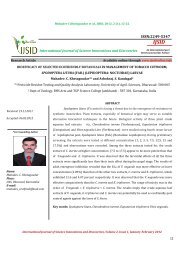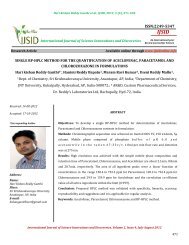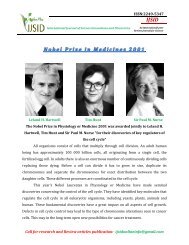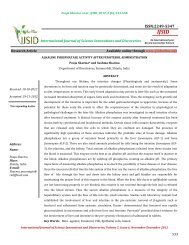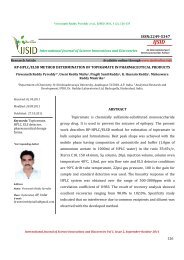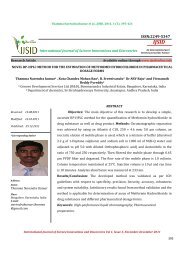The Nobel Prize in Physiology or Medicine 1934 ... - Ijsidonline.info
The Nobel Prize in Physiology or Medicine 1934 ... - Ijsidonline.info
The Nobel Prize in Physiology or Medicine 1934 ... - Ijsidonline.info
Create successful ePaper yourself
Turn your PDF publications into a flip-book with our unique Google optimized e-Paper software.
ISSN:2249-5347IJSIDInternational Journal of Science Innovations and DiscoveriesAn International peerReview Journal f<strong>or</strong> Scienceacquired item of factual knowledge. And that has been the case <strong>in</strong> the present<strong>in</strong>stance.With a view to aff<strong>or</strong>d<strong>in</strong>g a background aga<strong>in</strong>st which the discoveries of theprize-w<strong>in</strong>ners may stand out <strong>in</strong> stronger relief, I propose to say a few w<strong>or</strong>ds as tothe function of the liver <strong>in</strong> general. We are all aware that the function of the liver isto secrete bile, to be discharged <strong>in</strong>to the bowel. As is well known, the bile is of greatimp<strong>or</strong>tance <strong>in</strong> aid<strong>in</strong>g the process of digestion. This function of the liver is termed itsexternal secretion, its products by degrees reach<strong>in</strong>g the surface of the body. Besidesthat, however, the liver has other functions; it has f<strong>or</strong> <strong>in</strong>stance also a so-termed<strong>in</strong>ternal secretion. <strong>The</strong> first fact respect<strong>in</strong>g an <strong>in</strong>ternal secretion that science wasable to reveal to mank<strong>in</strong>d b<strong>or</strong>e reference actually to the liver, be<strong>in</strong>g the discovery,made <strong>in</strong> 1855 by the great French physiologist Claude Bernard, of the liver'sglycogenic function, i.e. of the imp<strong>or</strong>tant part played by the liver <strong>in</strong> the metabolismof sugar <strong>in</strong> the body. On demand the liver supplies the sugar that the body requiresf<strong>or</strong> its n<strong>or</strong>mal function<strong>in</strong>g. Claude Bernard gave that process the name of «unesécrétion <strong>in</strong>terne», thereby creat<strong>in</strong>g the term: «<strong>in</strong>ternal secretion», of which we hearso much at the present day. S<strong>in</strong>ce his time the the<strong>or</strong>y that he first enunciated hasbeen built up and amplified very materially. Thus, it is known now, respect<strong>in</strong>g anumber of glandular <strong>or</strong>gans, that, <strong>in</strong> addition to any external secretion that they maybe capable of, they also possess an <strong>in</strong>ternal secretion, that they consequentlymanufacture products that are delivered directly <strong>in</strong>to the blood, and which aresubsequently conveyed via the blood vessels, to remote parts of the body, where <strong>in</strong>other <strong>or</strong>gans they give rise to impulses, accomplish effects, that are of the verygreatest, <strong>in</strong>deed often of a vital, imp<strong>or</strong>tance f<strong>or</strong> the body. To those products, whichthe <strong>in</strong>ternal secretion supplies, the English physiologist Starl<strong>in</strong>g has given the nameof h<strong>or</strong>mones. We are now acqua<strong>in</strong>ted with a very considerable number ofh<strong>or</strong>mones. Time, however, does not admit of my enter<strong>in</strong>g <strong>in</strong>to the subject further; Iwill only call attention <strong>in</strong> pass<strong>in</strong>g to the latterly so much discussed sexual h<strong>or</strong>mones,Call f<strong>or</strong> research and Review articles publication: ijsidonl<strong>in</strong>e<strong>in</strong>fo@gmail.com



